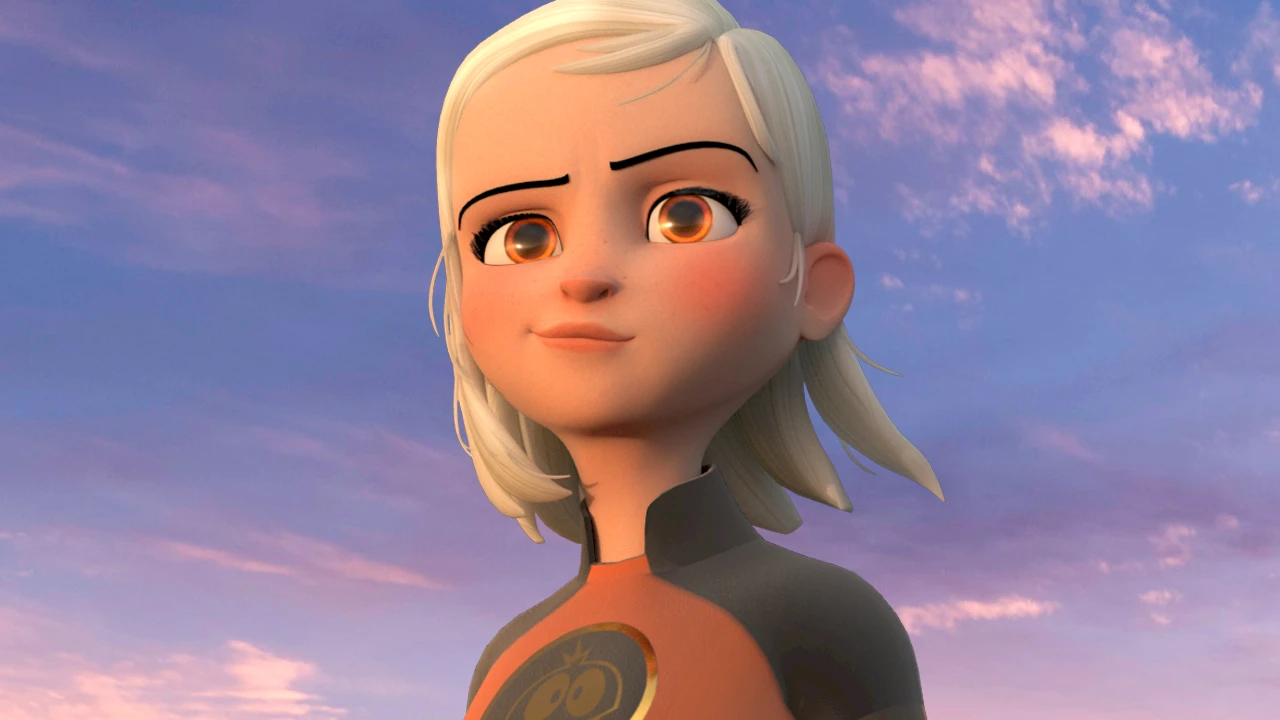Today, writer Barbara Roberston, drops by the Animation Mentor blog to give you a behind-the-scenes look at the visual effects and effects animators in Cloudy with a Chance of Meatballs 2. Cloudy 2 is currently number 1 in US theaters brining in $35 million last weekend alone.
Huge props to the crew at Sony Pictures Animation!
-The Animation Mentor Crew
—
FLUID EFFECTS
Effects animators played an important role in Cloudy with a Chance of Meatballs 2
By: Barbara Roberston
A coconut milk waterfall, maple syrup bog, food-animal hybrids. It could only be Sony Pictures Animation’s sequel Cloudy with a Chance of Meatballs 2. With color saturation pushed to the max, the pun-filled comedy splashed into the top box office slot opening weekend.
SPA’s latest feature film returns the inventive nerd Flint Lockwood (voiced by Bill Hader) to the screen to save the world once again from his infamous food-making machine. This time, the machine has produced food-animal hybrids and turned Swallow Falls into a food-centric Jurassic Park populated with such punny creatures as tacodiles, hippotatomuses, flamangoes, shrimpanzees, cantalopes, mosquitoasts, watermelophants, buttertoads, and apple pie-thons.
We spoke with Pete Travers, visual effects supervisor at Sony Pictures Imageworks, where a crew of animators and artists created Cloudy 2. In animated feature production, the visual effects supervisor manages nearly everything except story, animation, and design. In other words, modeling, rigging, surfacing, lighting, compositing, rendering, and, of course, effects.
Thirty effects animators on Travers’ crew supervised by Theo Vandernoot paired with effects animation lead Joseph Cavenaugh, created what we think of as visual effects in live action films.
“People think effects in an animated film can’t be that hard because it’s a cartoon, but what our crew did was really hard,” Travers says. “At the epicenter was fluid simulation. Cloudy 2 takes place in a big world, so the simulations had to vary. And, we couldn’t shortchange anything – we really had to run full simulations.”
The simulations in this animated sci-fi comedy, presented unique challenges. First, they liquids in whatever form had to be in scale with the size of the edible characters. Milk became an ocean; syrup, a river. “When Barry the strawberry drops into the coconut milk, we needed to have that look like a strawberry in milk,” Travers says, “but Barry is 20 times bigger than a strawberry. So, we had to scale the fluid simulation up 20 times.”
And, Barry was one of many larger-than-life characters. “Every fluid simulation had to be scaled up, the coconut milk, the breakfast bog, the lagoon,” Travers says. “The banana ostriches are eight feet long. When Barry poops out strawberry jam, that had to be scaled to the apparent size of the food.”
Second, the simulations, which rely on physics, needed to react to animation that doesn’t follow the laws of physics.
“The simulation engine gets confused by accelerations that in the real world are impossible,” Travers says. “And that adds to the complexity of what we’re doing. Most of the time with fluid simulations, you plug in the numbers and 90 percent of the time right out of the gate, it explodes. You have to run a bunch of simulations to make it work.”
Travers provides an example using a scene with the character Sam (voice by Anna Faris) walking through the maple syrup breakfast bog. The simulation engine needed to move the syrup as she walked, which was faster than physically possible. “She literally went from zero motion in one frame,” he says. “She was moving so fast the syrup launched 100 feet away.”
It was up to the effects animators to find a way to move the syrup believably. Similarly, when the car speeds down a coconut milk river, the directors wanted to maintain the cartoony style of animation, but the simulation couldn’t handle the extreme changes in acceleration caused by the cartoony animation style.
The effects animators work primarily in Side Effects Software’s Houdini. On screen, they see a box that contains the digital representation of a fluid the simulation engine will move using parameters based in physics. “Defining the size of the box is one of the trickiest parts,” Travers says. “If you want an open ocean and try to run a fluid simulation in a box that’s too tight, the splashes will bounce off the walls.”
To control the simulation, the effects artists enter parameters, that is, the physical forces such as gravity, the cohesive tension of the fluid, and so forth, that work to move the fluid. And then, change the parameters until the simulation looks the way they want.
“We don’t break the physics,” Travers says, “but, if you know gravity in the real world is 9.8 meters per second squared, you don’t say, ‘I’m never going to change that co-efficient.’ Everything is fair game toward making the shot look good. So, you know you need gravity, but you have to let go of constraints and assumptions from the real world. You might set gravity at 2 or 1000 to make the simulation work. If it looks good, it is good.”
When appropriate to the shot, the effects artists might place a CG object like an animated boat on the surface, or insert a character walking through the fluid. Then, they start the engine, and the fluid starts moving.
“In the real world, the fluid would move the object, but in our world, because the object is keyframe animation, and animation is king, the simulation reacts to the explicit motion of the animated object,” Travers says. “We run the simulation. It breaks. We change the parameters. We run it again.”
Sometimes, the effects animators can’t find a way to make it look good. When that happens, they ask for changes by animation crew. “We worked with (animation supervisor) Pete Nash to find that happy medium,” Travers says. “With the coconut milk waterfall, we’d run it, look at it, run it again and again. Finally, we decided the car was just too fast and the simulation would not work, so we had to massage the animation curves.”
One of the most difficult sequences for the effects animators takes place in the sardine circle and reveals the full impact of the machine’s handiwork – hundreds of characters in and around the big lagoon. “It was 1000 frames long, a nightmare to do,” Travers says. “Beautiful though.”
Because the directors wanted individual splashes for the various foodimals and food creatures, the effects artists needed to run simulations for all the animals separately and then blend them together.
“The surface of a simulation is not like normal geometry made of nurbs and polygons,” Travers says. “It’s an implicit surface that gets created and recreated on every frame. You can’t texture map this surface in a conventional sense. So, if you want more detail in the wavelets moving through the water, you have to build that into the simulation. And, you have to do that blend in three dimensions. You are creating a 3D surface.”
To create these effects takes what Travers calls a combination of discipline and artistry. “I have a problem when someone refers to these artists as technical people rather than creatives,” he says. “The most creative people I’ve met are programmers and effects artists. There is tremendous creativity going on. You have to maintain technical understanding, but you also have to make the effects look good and match the style of the film.”
The effects artists on his team and those he’s met have varied backgrounds. “The greatest effects programmer I’ve met had a degree in political science,” Travers says. “But a lot come with computer science backgrounds. There isn’t a definitive path, but, you have to know how to program. Effects animators have to pop the hood of the ‘car’ and see what’s going on. You can’t just drive it by instinct and think you’ll be good.”
In addition to diligence and creativity, these artists need to be patient to solve the unique problems that come with creating simulations melt nicely with cartoony animation. Some shots with the car moving down the coconut milk waterfall took a month of tweaking to get right.
“My hat’s off to the effects animators,” Travers says. “I’d sit in dailies amazed. There’s a shot I’ll always remember. The car had just gone down the waterfall. It cascades through the fruit rapids before it enters a pool at the bottom. That down angle shot is just amazing. You can look at a corner of the simulation and it looks so real. This wasn’t even possible five years ago.”




